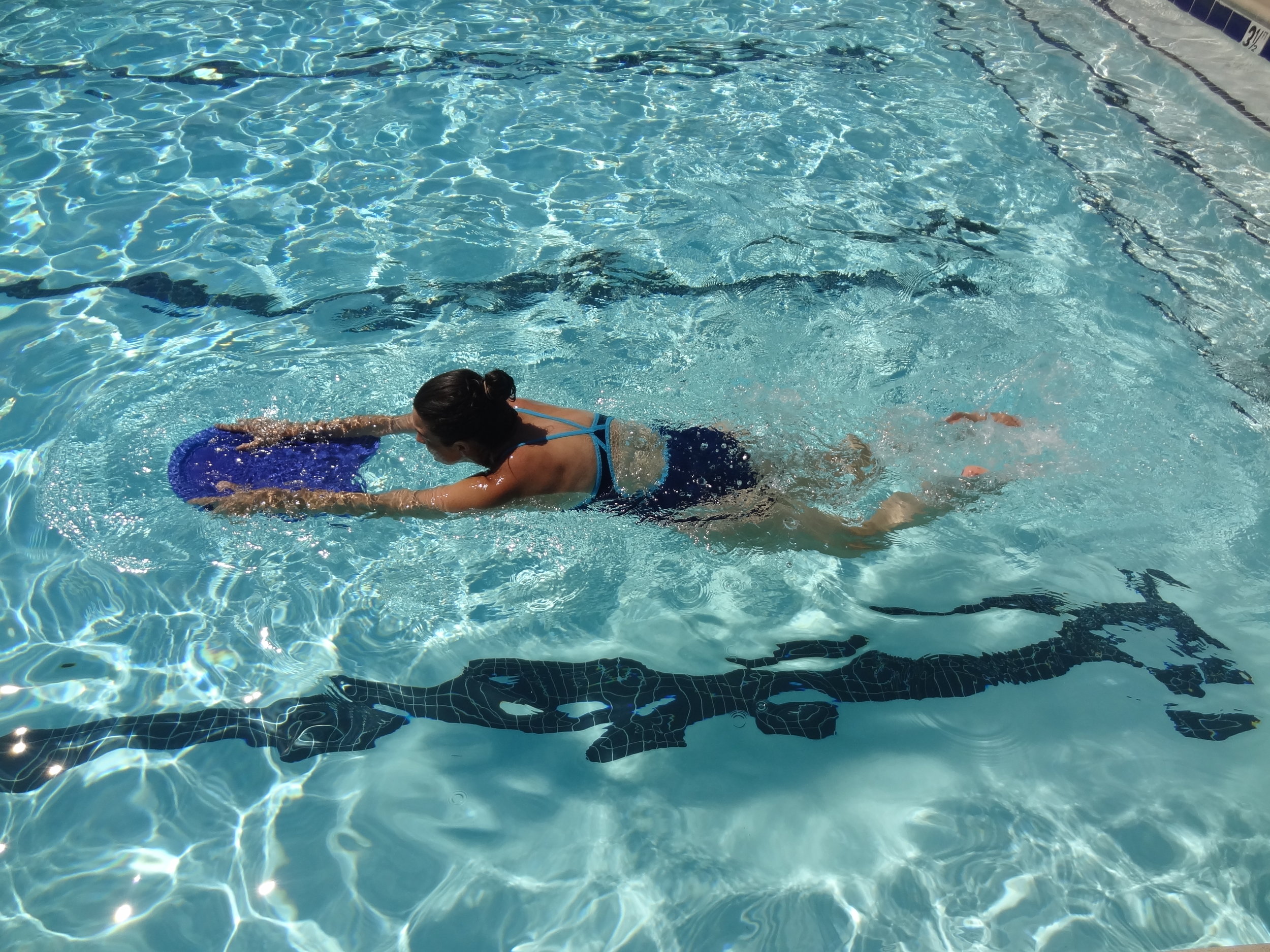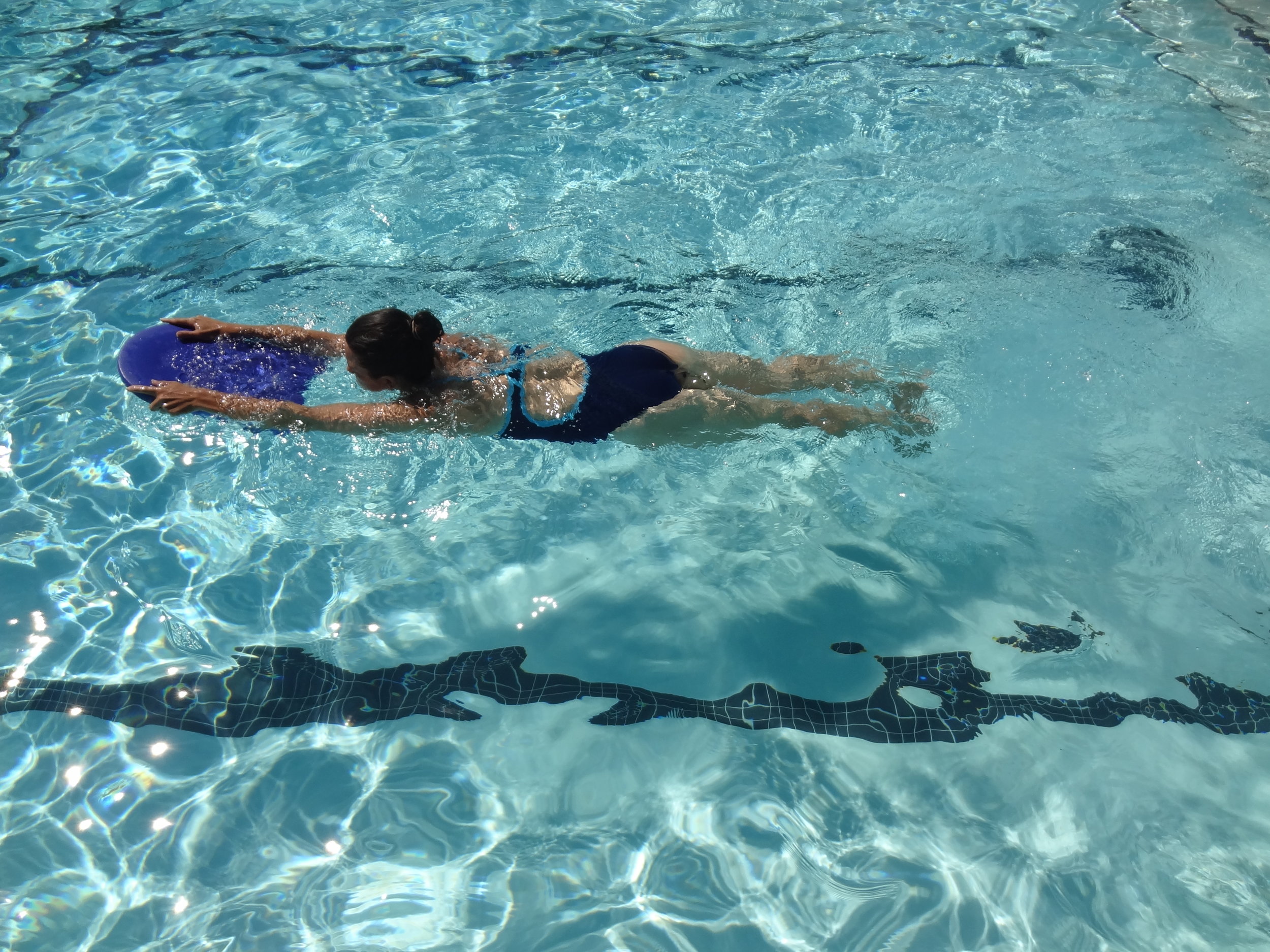TECHNIQUE
Today we are going to learn how to butterfly kick using a kickboard.
IMPORTANCE
The butterfly stroke is important because it is one of the most challenging strokes to learn in swimming. This stroke helps a swimmer build coordination, power and endurance.
VOCABULARY
Butterfly stroke: a swimming stroke done face down and the arms are thrust out of the water in a circular motion while the legs move in an up-and-down motion.
When butterfly kicking with a kickboard, it is important to:
1. Hold onto the top of the kickboard.
4. Use your core and hips to create a whipping motion with your legs driving your feet downwards (like a dolphin).
2. Keep your body inline with the surface of the water.
3. Extend your legs keeping your knees and feet together.
PRACTICE
- Spread out along the edge of the pool. When I say, "GO!" practice your butterfly kick.
- This time, I will divide the class into partners. With your partner, Ro Sham Bo to decide who will go first. When I say, "GO" breaststroke kick to the other side of the shallow end. Your partner will guide your kickboard. Take turns when you reach the other side.
WATER BASEBALL II
TIME
20-30 minutes
NUMBER OF STUDENTS
No restrictions
EQUIPMENT
4 kickboards
5 dots
1 beach ball
OBJECTIVE
Today we are playing Water Baseball II. In this game, the objective is to get more runs than the opposing team by butterfly kicking using your kickboard.
INSTRUCTIONS
- I will divide the class into two teams. I will decide which team will bat first and which team will start in the field.
- If you are batting first, decide the batting order and line up single file behind home plate.
- Your kickboard will be used as your bat.
- If you are fielding first, decide which position each student will play (catcher, 1st base, 2nd base, 3rd base, outfield).
- I will choose a pitcher to begin the game.
- A batter is out if:
- the ball is caught in the air
- the ball is thrown to the base before the batter swims to it
- A ball is considered foul if it is hit out of the pool.
- If you hit the ball, begin butterfly kicking using your kickboard to 1st plate.
- Batters and fielders will switch after three outs or after a team has scored five runs.
Game 1: Play as indicated above.
Exit Ticket: Have students butterfly kick using a kickboard on their way to exit the water.
TEACHING TIPS
- Approach:
- Divide teams equally based on athletic ability.
- Remind students to be honest when tagging the bases.
- Remind students that because the bases are under water that we will give “close calls” to the batting team.
- ELL Accommodation:
- Post labeled pictures of skills and game play. (step by step)
- Partner with proficient English speakers for directions/modeling and reflections.
- SpEd Accommodation:
- Allow students extra time to master the skill.
- Allow students to respond with the help of pictures, a peer helper, manipulatives, or teacher.
- Set individual goals for physical or behavioral modifications.
- Reflection:
- How does the butterfly kick help a swimmer?
- Which skill was more difficult for you? Why?
SHARKS AND MINNOWS III
TIME
10-15 minutes
NUMBER OF STUDENTS
No restrictions
EQUIPMENT
1 kickboard per student
OBJECTIVE
Today we are playing Sharks and Minnows III. In this game, the objective is to butterfly kick using your kickboard past the shark (tagger) and be the last minnow swimming.
INSTRUCTIONS
- I will select one of you to be the shark. The shark must start in the middle of the shallow end.
- Everyone else will line up shoulder-to-shoulder along the edge of the shallow end.
- When I say, “GO!” the minnows have to butterfly kick using their kickboard to the other side of the shallow end without being tagged by the shark.
- If you are tagged, you become seaweed and must place your kickboard outside of the pool.
- Seaweed must stand exactly where they were tagged and must keep their feet planted, only moving their arms.
- If you make it to the other end without being tagged, you are safe.
- We will begin a new round when all the minnows get to the other side or are tagged by the shark.
- We will start a new game when there is one minnow remaining.
Game 1: Play as indicated above.
Game 2: Add two sharks to the game.
Exit Ticket: Have students butterfly kick using a kickboard on their way to exit the water.
TEACHING TIPS
- Approach:
- If the game is lasting longer than expected, add a second shark.
- ELL Accommodation:
- Post labeled pictures of skills and game play. (step by step)
- Partner with proficient English speakers for directions/modeling and reflections.
- SpEd Accommodation:
- Allow students extra time to master the skill.
- Allow students to respond with the help of pictures, a peer helper, manipulatives, or teacher.
- Set individual goals for physical or behavioral modifications.
- Reflection:
- How does the butterfly kick help a swimmer?
- Which skill was more difficult for you? Why?
SAVE THE TURTLES
TIME
15-25 minutes
NUMBER OF STUDENTS
6-32 students per game
EQUIPMENT
10 short cones
1 kickboard per 2 students
1 beach ball per student
Optional: 4 large cones
OBJECTIVE
Today we are playing Save the Turtles. In this game, marine biologists (swimmers) are on assignment in Turtle Island to save the turtles from the pirates (throwers). The objective is to butterfly kick using a kickboard across the pool to bring the turtles back to the biology lab (baseline) safely.
INSTRUCTIONS
- Before the game begins, I will divide the class into two teams the marine biologists and the pirates.
- Marine biologists will line up shoulder-to-shoulder with their kickboard on one side of the shallow end while the pirates will throw from the side lines.
- When I say, “GO!” the marine biologists will butterfly kick using a kickboard to the other side of the shallow end to grab a turtle (short cone).
- If a marine biologist is hit by a cannonball (beach ball) thrown by a pirate, he/she must return the turtle and wait to be rescued by another marine biologist. Both of you will receive a free swim back to the biology lab.
- All throws must be made below the neck. Heads shots do not count.
- Marine biologists may only save one turtle or rescue one stranded teammate at a time.
- We will begin a new game when all turtles have been rescued or all biologists are stranded on Turtle Island.
Game 1: Play as indicated above.
Game 2: Add tall cones that marine biologists must transport in pairs back to the biology lab.
Exit Ticket: Have students butterfly kick using a kickboard on their way to exit the water.
TEACHING TIPS
- Approach:
- Have a student be a ball master and toss the cannonballs back to the pirates.
- If students are arguing over being hit or not, consider adding a ‘throwers choice rule’. If their body is in line with the surface of the water, the ball must land on top.
- Adjust the amount of turtles depending on class size and time.
- ELL Accommodation:
- Post labeled pictures of skills and game play. (step by step)
- Partner with proficient English speakers for directions/modeling and reflections.
- SpEd Accommodation:
- Allow students extra time to master the skill.
- Allow students to respond with the help of pictures, a peer helper, manipulatives, or teacher.
- Set individual goals for physical or behavioral modifications.
- Reflection:
- How does the butterfly kick help a swimmer?
- Which skill was more difficult for you? Why?







